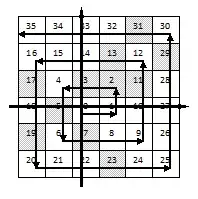Here's an attempted explanation of the first formula. It applies only in the open region to the right of the two lines $y=\pm x.$ If we show it is right when $y=0$ it will follow, since then the added $y$ will make it OK on the vertical line through $(x,0)$ while staying in the region.
A few sketches show that if we remove the points on the vertical line through $(x,0)$ with $y\le 0,$ what is left is a square of lattice points of side $2x-1.$ Then we need to add $x$ more, to account for the vertical part removed. But we also need to subtract one since the labeling starts at $0$ for the origin. This gives us
$$(2x-1)^2+x-1=4x^2-3x,$$
which then on adding $y$ as noted to account for where one is on the last vertical part of the journey, gives the desired formula $4x^2-3x+y.$
The others are likely doable in a similar way, I'd suggest looking for a convenient point on an axis for a starting idea, and after some sketches finding a square (or maybe a rectangle near square) of lattice points which preceed your chosen axis point.

